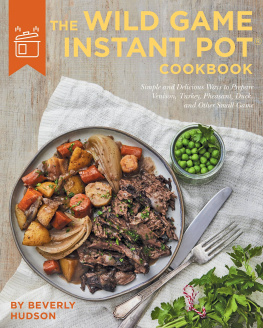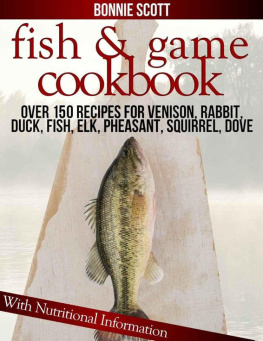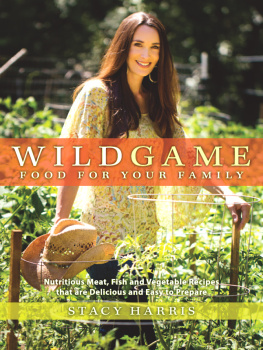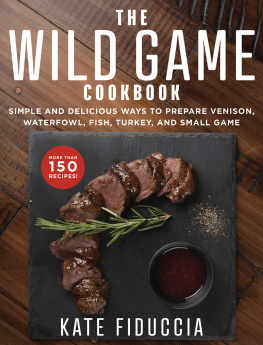Contents
Page List
Guide
Cover
THE WILD GAME INSTANT POTCOOKBOOK
Simple and Delicious Ways to Prepare Venison, Turkey, Pheasant, Duck, and Other Small Game
BY BEVERLY HUDSON
Copyright
2020 by Quarto Publishing Group USA Inc.
First published in 2020 by Voyageur Press, an imprint of The Quarto Group, 100 Cummings Center, Suite 265-D, Beverly, MA 01915, USA.
T (978) 282-9590 F (978) 283-2742 QuartoKnows.com
All rights reserved. No part of this book may be reproduced in any form without written permission of the copyright owners. All images in this book have been reproduced with the knowledge and prior consent of the artists concerned, and no responsibility is accepted by producer, publisher, or printer for any infringement of copyright or otherwise, arising from the contents of this publication. Every effort has been made to ensure that credits accurately comply with information supplied. We apologize for any inaccuracies that may have occurred and will resolve inaccurate or missing information in a subsequent reprinting of the book.
Voyageur Press titles are also available at discount for retail, wholesale, promotional, and bulk purchase. For details, contact the Special Sales Manager by email at or by mail at The Quarto Group, Attn: Special Sales Manager, 401 Second Avenue North, Suite 310, Minneapolis, MN 55401, USA.
10 9 8 7 6 5 4 3 2 1
ISBN: 978-0-7603-6924-1
Digital edition published in 2020
eISBN: 978-0-7603-6925-8
Library of Congress Cataloging-in-Publication Data is available.
Design and page layout: Tango Media Publishing Services, LLC
Food Styling: Natasha Taylor
Photo Credits
When multiple photos appear on a page, they are identified by letter, listed clockwise from the top left.
Cover and interior photographs by Glenn Scott, with the exception of .
.
About the Author
Beverly Hudson is a writer and recipe developer. She lives in Minneapolis, Minnesota, with her husband and two cats.
The recipes in this book were originally developed by Teresa Marrone for the book Slow Cookers Go Wild!, which was published by Creative Publishing International in 2006.
CONTENTS
INTRODUCTION
I magine coming inside after a cold day in the fieldor a hard day at the office, for that matterand being able to whip up a hearty, meltingly tender venison stew in minutes. With an Instant Pot, dishes that would otherwise take hours of simmering can be ready in no time. And with this book, you can prepare that stew, or any of these other tasty wild-game dishes, and have dinner on the table quickly and with very little last-minute work.
This book is written especially for hunters and for those who want to prepare wild game. Wild game is perfectly suited to pressure cooking, which excels at turning tough cuts of meat into tender morsels. If you have an Instant Pot, chances are good that you have plenty of recipes for beef, chicken, and porkbut how many do you have for venison, pheasant, and wild boar?
Wild game has different cooking characteristics than domestic meat, and for best results, you need to take this into account when preparing it, whether in an Instant Pot or slow cooker, on the stovetop or in the oven. Beef, for example, has much more external fat and internal marbling than venison; the meat is basted and tenderized as it cooks. Venison is quite lean, with virtually no internal marbling; the external fat tends to be strongly flavored and is removed during butchering. It follows, then, that a recipe for nicely marbled beef steaks wont work properly if prepared with lean venison steaks.
Domestic poultry is generally sent to market at a very young age, when the meat is still quite tender; plus, due to modern agricultural practices, chickens and domestic turkeys get very little exercise and therefore do not develop muscle firmness. Compare that to a wild pheasant or wild turkey, which spends its life running in the fields and flying freely. Wild birds have to work hard to survive, and their meat is much less tender than that of domestic birds; plus, wild birds are often much older when harvested than are domestic birds (and meat from older animals is less tender than that from younger animals, whether domestic or wild).
Of course, wild game also tastes quite different than domestic meat. Wild turkeys and wild rabbits, for example, have meat that is darker and much more flavorful than that of their domestic cousins. Many wild boars are descendants of domestic pigs, but the similarity ends there; boar meat is richer and nuttier than domestic pork, with a much more aggressive flavor that most hunters find irresistible. Birds like ruffed grouse and Hungarian partridge have no domestic counterpart; and who ever heard of raising squirrels for meat?! All of these wild foods are unique and delicious, and they benefit from recipes that let their flavor shine through. The Instant Pot allows you to prepare wild game in a manner that retains all its natural flavor; most recipes are simple and quick to get started. What more could you ask for?
The Rise of the Modern Electric Pressure Cooker
The first pressure cooker was developed more than three hundred years ago by a French inventor who realized that trapping steam inside a pot as the liquid inside heated would increase the pressure on the liquid, meaning that more energy would be required to convert the liquid to gas and higher-than-boiling-point temperatures could be achieved for faster cooking. A pressure cooker designed for everyday home use was introduced in the United States in the 1930s.
It used to be the case that pressure cooking meant a giant, serious-looking stovetop contraption with a complicated lid, complete with dials and weighted valves and the nerve-wracking sense that the high-stakes situation could go south at any moment. The first electric pressure cookers came on the market in the 1990s and boasted mechanical timers and lids that automatically locked when the pot was under pressurea welcome safety feature. But it wasnt until the Instant Pot brand began production of the digitally controlled electric pressure cooker, in 2010, that the super-high-heat cooking method really took off.
Now, instead of clamping down a heavy pot lid, adjusting the burner to achieve a high-pressure cooking environment, and carefully monitoring an analog pressure-gauge dial, all a home cook has to do is twist on a lid (which will helpfully alert the user if its not properly locked), push a couple of buttons, and wait for the appliance to signal with a charming bleep or two that its work is done. Cooking at high pressure has become easier and more convenient than ever: Not only is the process relatively straightforward, but the inner pot is easy to clean by hand or in the dishwasher, so theres no reason not to use the appliance often.














